“Tandoor: A kind of oven that seems to have originated in Central Asia; the word is also sometimes written tandur or tandir. Tandoor ovens were introduced to the Subcontinent with the Moghul invasion and are associated with Moghul cuisine and traditions. They are commonly found in Pakistan and northern India, as well as in restaurants all over India that cater to tourists or truck drivers. The ovens are usually made of coarse clay that is sunbaked and are barrel shaped, with an open top. A fire is built at the bottom of the oven (or the oven may be gas fired); when the walls are very hot, the fire is damped or lowered, and flattened pieces of bread dough, either leavened or unleavened, are slapped onto the inside oven walls, where they bake very quickly. Tandoors are also used for cooking meat, fish, and chicken; the meat is marinated or rubbed with flavorings, then threaded onto skewers and lowered into the oven.”
– Jeffrey Alford & Naomi Duguid, Mangoes & Curry Leaves: Culinary Travels Through the Great Subcontinent
Buenos Aires – I woke up this morning wishing that Craig Claiborne was still alive. He was on my mind because I’m reading through David Kamp’s dense, but fascinating The United States of Arugula, a retrospective the “American Food Revolution”. But in particular what brought him to mind was that he was a restaurant critic who, unlike many of today’s crop, didn’t make any effort to be anonymous – not that most of those who make the effort succeed, every restaurant of any note that I ever set foot in in New York had posted pictures in the kitchen and/or waitstaff areas of one or more of the major critics in town so that they could be recognized. More than that, however, was that he cultivated friendships with chefs and restaurateurs – unlike, say, the Anton Ego character of the film Ratatouille, who is not anonymous, and comes in to strike fear in the hearts of one and all – Claiborne clearly took a different path. What had the wish on my mind this morning, beyond just that, well, I’d like for the man to still be alive, is that I want to call him up and ask, “How do you give honest criticism of a restaurant where you’re friends with the owners?” There are two parts to that – one, is having to make sure that you’re not letting things slide just because you like them, and the other is, knowing that you’re delivering a public critique about someone’s work. I know, that somehow, he managed to pull it off without compartmentalizing his life into work and social.
Now, I know that it’s possible that the above might create a sense of the ominous, that I’m about to try to rip to shreds the restaurant of a friend, so first, let me assure you that I’m not. Sorry, I know you were hoping. It’s just a subject that’s been on my mind, it came up twice in my mini-reviews of restaurants from New York last week. It came up the week before in my review of Provence restaurant. And, as I settle into porteño culture, and make friends throughout the restaurant business here, I’m finding that it’s starting to come up more and more here.
So, on to our evening out at Tandoor, Laprida 1293, corner of Charcas, in Barrio Norte, 4821-3676. I gave this spot a teaser back in March, prior to its opening in April. Now, the question comes up, why haven’t I reviewed it during the last 3½ months? In fact, I admit that I hadn’t even been there until the other night – though there was no particular reason, I guess I just hadn’t gotten a hankering for Indian food, and the guys were so busy getting the place open and running it that we basically weren’t even in contact, and it simply slid off my radar. In terms of reviewing it, I actually considered not doing so yet… one of the things Craig told me many years ago was that he’d always felt that it was unfair to both a restaurant and the public to review a spot that hadn’t been open at least a year – for the former, it gave them a chance to truly get their act together and show their stuff, and for the latter, it meant that he was reviewing a spot that wasn’t likely to close two weeks later because they simply hadn’t gotten it together. A very different culture of reviewing in comparison to what has happened in major cities in the U.S. of late, where the reviewers practically batter the doors down on opening night, rushing to scoop each other and be the first to point out that the paint isn’t even dry on the walls. Having worked through several restaurant openings in my life, it used to feel ridiculous that we would get critiqued on how things went in our first week of being open – what other business gets judged like that?
Have I dragged this out enough yet? I didn’t plan it, I just started writing… On to Tandoor – I love the room. Cream colored walls below, with a high celiing and the upper part of the walls painted a deep red, nearly cinnabar color. Lots of big windows. The high ceilings are a plus, because the room is all hard surfaces, and were they to be normal height, the sound volume would be deafening. As it is you can pick up bits of conversation bounced off walls from various parts of the room, but the level is low, and it’s easy to have a conversation with the folks at your table. Service was swift and friendly, and it wasn’t just because we knew the owners, everyone was being greeted within mere moments of their arrival. The lighting is fairly bright, but all indirect, so comfy on the eyes, and, you can actually read the menus rather than squinting with the aid of a candle.
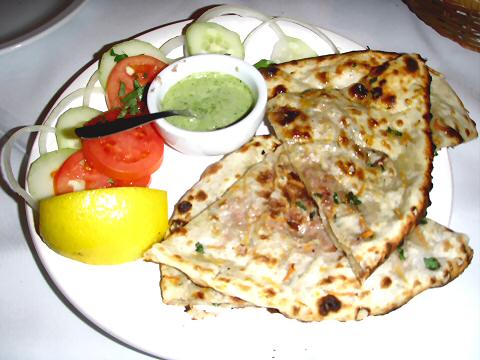
We started off with a couple of appetizers, the keema naan, which was the hands-down winning dish of the evening, perfectly cooked naan flatbread filled with a minced lamb mixture that was tangy and delicious, squirted with fresh lemon, and dipped into a tangy cilantro yogurt sauce… which, by the way, brought to mind sauces… now, I realize that this may be purely a norteamericano affectation, I don’t know, but it seems like every Indian restaurant 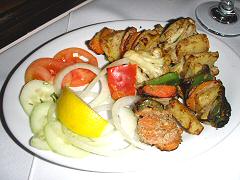 I’ve ever dined in there serves up a little trio of sauces – a tomato onion chutney, a tamarind sauce, and the cilantro yogurt sauce. I’ve noticed that the few Indian spots here, including Tandoor, don’t – I’ll have to ask about that. The other dish we tried was the vegetable tikka, a simple plate of vegetables that have been coated in a yogurt and spice mixture and then “grilled” in the tandoor oven. It was tasty, the flavors were all there, but it was missing something… a little rice, or maybe it was just that we’d already gone through our basket of flatbread that came on the side – we could have eaten the veggies wrapped in pieces of that. Maybe those three dipping sauces… no, really, I loved the flavors, and though interestingly, one of the owners pointed out that he wasn’t fond of the way the spices were just crusted on the outside of the vegetables, I actually liked that, it gave the dish a little textural crust.
I’ve ever dined in there serves up a little trio of sauces – a tomato onion chutney, a tamarind sauce, and the cilantro yogurt sauce. I’ve noticed that the few Indian spots here, including Tandoor, don’t – I’ll have to ask about that. The other dish we tried was the vegetable tikka, a simple plate of vegetables that have been coated in a yogurt and spice mixture and then “grilled” in the tandoor oven. It was tasty, the flavors were all there, but it was missing something… a little rice, or maybe it was just that we’d already gone through our basket of flatbread that came on the side – we could have eaten the veggies wrapped in pieces of that. Maybe those three dipping sauces… no, really, I loved the flavors, and though interestingly, one of the owners pointed out that he wasn’t fond of the way the spices were just crusted on the outside of the vegetables, I actually liked that, it gave the dish a little textural crust.
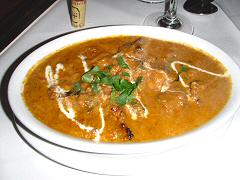
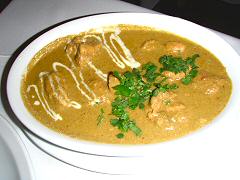
We moved on to the main courses… and here’s my one and only thing that I think needs to be changed on the service, though perhaps I should be used to it in restaurants here, it’s the same in the other Indian spots, and in Chinese restaurants as well… I’d have liked it if the waiter had asked us when we were ordering if we’d like rice with our dishes. It’s not served automatically here, you have to order it, and so, when our entrees arrived, we realized we needed a plate, which required flagging someone down, ordering it, and waiting for it, which didn’t take long, but was noticeable – I’d love to see them either just simply bring a small dish of rice as part of ordering main courses, or at least ask in advance. The chicken tikka masala, on the left, was mildly spicy, rich, full of great flavors – one note, the restaurant offers the option of making the dishes more spicy, with two levels above “as is”… but I had an interesting conversation with one of the owners one night – he pointed out that unlike some cuisines where chilies or other spices may be sauteed into a pan while making an sauce to order, or topped with extra spices that are raw, Indian sauces are cooked slowly over low heat, which give the spices time to meld and mellow – so while they can throw in extra chilies, it tends to destroy the balance of the sauce, and it just tastes spicy. That’s good enough for me to not ask the chef to change the way he makes the dishes, we left them “as is”. The dish on the right is a chicken sha jahan, a sauce of nuts and “exotic spices” – I’ll let you know if I find out what’s in it – delicious! Mildly sweet, and really quite good.
One last comment on the rice… basmati rice is typically known for being a delicately fragrant rice, and also because of the structure of the grains, tends to stay firm and separate rather than sticky when cooked. I don’t know if it’s that they’re using a different type of rice, or if it’s something about the way it’s being cooked or held to temperature, but the rice came out sticky and clumped together, and we thought lacking in that usual fragrance. It was fine with the main courses ladled over it, but on its own wasn’t as good as what I normally think of as basmati.
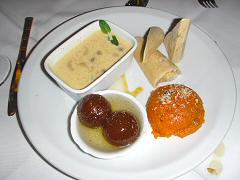 This is just plain smart. Tandoor offers up four different desserts, but also offers up a tasting plate of all four, for sharing. A rice pudding-ish sort of thing in the rectangular dish – the flavors spot-on, though perhaps a little too soupy – we’d have liked more rice less milk… The other three, real winners – the kulfi, which is sort of like a semi-freddo, flavored with rosewater and nuts; the gajar halva, which was my personal favorite – like a carrot cake without the cake… carrot pudding perhaps? And, the gulab jamun, a sort of gooey, milk-based, fried ball soaked in sugar syrup… I can’t think of a way to describe it that sounds appetizing, but it is, it really is.
This is just plain smart. Tandoor offers up four different desserts, but also offers up a tasting plate of all four, for sharing. A rice pudding-ish sort of thing in the rectangular dish – the flavors spot-on, though perhaps a little too soupy – we’d have liked more rice less milk… The other three, real winners – the kulfi, which is sort of like a semi-freddo, flavored with rosewater and nuts; the gajar halva, which was my personal favorite – like a carrot cake without the cake… carrot pudding perhaps? And, the gulab jamun, a sort of gooey, milk-based, fried ball soaked in sugar syrup… I can’t think of a way to describe it that sounds appetizing, but it is, it really is.
Overall, high marks for service. The food, quite good, though I’d say that there’s room for improvement – one note, we took a little tour of the kitchen after dinner, and I noted that because a large percentage of the food is being cooked in the tandoor, and the chef himself is doing all the tandoor cooking, the rest of the kitchen staff are doing little more than standing around and then adding sauces, garnishes, and plating things. At some point (and that’s one of the reasons for not reviewing a restaurant early on), he’s going to have to teach his staff how to work the tandoor, so that he can spend more time on the fine points. The wine list needs some serious work – it currently consists of a couple of inexpensive, lower quality wines, and then a few much more expensive wines… but they’re all “usual suspects”. Though I might typically go for a nice cold beer with Indian food, I think it’s quite possible to offer a really nice selection of good wines in all price ranges that will go well with it. Leaning towards the pricey side, though given the quality and service, it’s not out of line, with wine and tip, figure on close to AR$100 a person for a three course meal.
Was just reading your review of Taj Mahal and then came back and read this one. Have you ever been back? We were really happy with it when it opened up, authentic and all that, but it has sadly joined the other Indian restos here in town over time, offering bland, barely passable imitations of dishes that we used to love. They seem to have taken to cutting corners left and right, with cheaper quality, smaller portions, or at least portions that now consist of mostly sauce and almost no meat or veg, and regularly raised prices. If you ask for something spicy now it’s not noticeable if they added any. Thanks for the review on Taj, I think we’ll give it a try and hope we’re not disappointed too.
I’ve been back maybe half a dozen times, plus ordered food from them for delivery a couple of times. I have noticed a couple of things – the portion size I think I’d agree with you (though, interestingly, at least based on appearances, the portion size when you get delivery seems to be far bigger than the portion size served in the restaurant), as well as the prices have clearly gone up, but then, they have everywhere here in town, so that’s not a surprise. I hadn’t noticed a lower quality. The one thing that for me was a disappointment, though I understand it from a business sense, was that when the guys opened, they swore they were going to make things authentically and not start “blanding” the dishes down for local palates, because adding in spices at last minute, either in the kitchen or at the table just doesn’t produce the same result, but, I think they really had no choice if they wanted to stay in business, and it’s the route they’ve taken. The bulk of their clients are locals, not us expats, and telling them “spicy or nothing” isn’t a good business model for a regular restaurant (it works in Casa Saltshaker because we tend to alternate spicy meals with others, so locals can take their pick); nor is the expense, and waste, of having two versions of every dish. I know it’s been hard on them to figure out ways to keep the spicy versions as authentic as possible. Sometimes, as they say, reality bites.
[…] samosa and the second main course dish, and the only other Indian restaurant in the ‘hood is Tandoor, which is significantly more expensive for takeout or delivery – though, it’s […]
[…] friend Belli, how owns Tandoor restaurant here, used to joke that there were only 70 Indians here in Buenos Aires and half of them […]
[…] of spots we can turn to for reasonably authentic fare is a comfort. Now, close to home we have Tandoor, which is owned by friends of ours, and I do love it, but it’s pricey, and despite promises […]
[…] to another part of the world, and what comes down to a taco kit. Coming to us from the folk behind Tandoor, a delivery-only taco and burrito (and more) spot somewhere here in Recoleta in a hidden away […]
[…] here in Buenos Aires, back in the day. That’s changed a bit over time, and places like Tandoor and Taj Mahal have been offering really decent Indian food here, despite the local aversion to […]